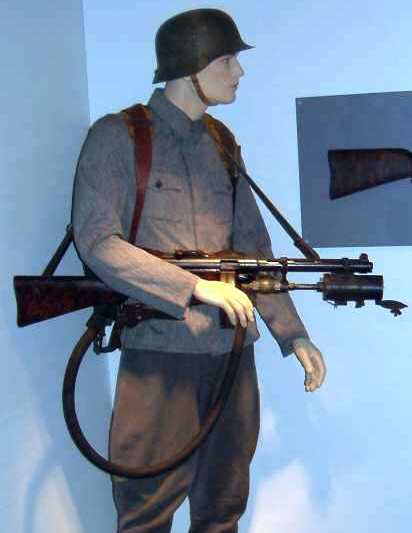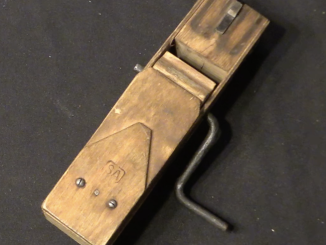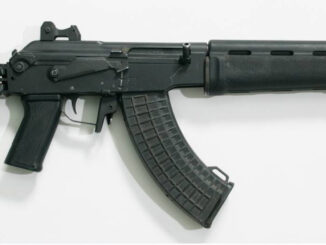A Finnish reader named Ossi sent us a photo and some information on a rather outlandish Finnish weapon developed at the tail end of the Continuation War with the USSR. It was a standard m/31 Suomi submachine gun, but with the addition of an underbarrel flamethrower(!). It is not particularly uncommon historically for flamethrowers to be more or less disguised to look like regular rifles from a distance, to prevent the enemy from being able to easily spot the men with flamethrowers and concentrate fire on them. This one, however, is the only one I’m aware of where the flamethrower is attached to a fully functional firearm.
Apparently this was field tested in the summer of 1944, but never went into production. Apparently the only remaining example is on display at the Finnish Military Museum (Sotamuseo) in Helsinki.
Thanks for the cool information, Ossi!





One grenade-launcher short of the full Ripley then? 🙂
Actually the device is known as flamethrower m/44.
Designed by sergeant M Kuusinen (InfantryRegiment 1) in spring of 1944.
Small amount of these were made and they were tested both in homefront and also by combattroops (for example CalvaryRegiment, PanzerDivision and EngineerBatallion 35).
At least two of these are known to being succesfully used in combat at summer of 1944.
At Loimola – Kagrakangas 1.Company/CombatEngineerBatallion 35 was subordinated to InfatryRegiment 56 to be used to destroy an fortified enemy stronghold.
During the battle (16.-17.08.) russians lost 160 men dead. Finnish lost 4 KIA and 35 WIA. Every member of the flamethrowersquad was honoured with an award. *
The total amount which was ordered was 100 but only maybe 40 were ever made.
The Continuation War ended and there was a total halt in all weaponmanufacturing.
Most were destroyed at the end of the war. Few of these were being used up to the late 1970`s by Finnish Border Guard. In Finland flamethrowers were combatengineers weaponsystem, not infantrys and Border Guard has its own troops during peacetime, at the time of war they are a part of Finnish army. Combatengineering, guerilla and many other specialtactics were a part of the training for Border Guards troops, that is why these flamethrowers were being used by BG but not by the army.
*
Aarno Söder – Pioneeripataljoona 35 Jatkosodassa 1941-1944
Kaino Tuokko – Jalkaväkirykmentti 56 1941-1944
And I cannot forgive myself for not buying one from military surplus-auction 1994 (Vammala OrdnanceDepot), it went for a lousy 2000marks (340€).
If it was on sale only 20 years ago, there must be still at least one in existence besides the one at the Military Museum. At that price there must have been a collector who picked it up for his collection.
No way! Underslung flamethrover? Never did I imagine those exist outside call of duty.
Do you know range of this underbarrel flamethrower? I except that with modern technology the 40mm WP (white phosphorus) grenade would be more feasible in incendiary role. Do you know any examples of 40mm or other WP grenades?
Suomi Sisu!!!
Kill ’em and grill ’em. I can think of so many uses for this… 🙂
Like what, Doc, dealing with a rabid zombie grizzly bear or a horde of Russian Strafbat soldiers?
I can’t think of too many bad situations that I could get into that this couldn’t get me out of. Gives a whole new meaning to “crowd control.” With a couple of spare tanks and a few extra drums, to quote the guy on “Breaking Bad”: “I am not in danger…I am the danger.”
Maximum range of the m/44 was 15 meters.
For one fillment of canisters it was able to fire 50-70 short flamebursts or 40-60 (one second) continuous flame.
It was more suitable to use it with Suomi smg with a muzzlebrake (SRJ).
One problem was that the leather- or canvassling burned from its frontend, so it was recommended to have a sling made of non-flammable material (steelwire).
Why such a contraption? It was noted that flamethrower-operators suffered massive casualities because they couldnt protect themselves on the battlefield. Hence they had a smg-gunner as a battlepartner. Still the casualities were high. But with m/44 attachment a flamethrower-operator had the capability to fight both as a FT-operator and a smg-infantrysoldier.
Markku Palokangas – Sotilaskäsiaseet Suomessa 1918-1988 Part 2 pages 290-291.
From a reasonable distance (over 20 meters) and unless you could see the tanks on the soldier’s back, this setup could have easily been mistaken for and underbarrel grenade launcher similar to the German cup-type muzzle-mounted discharger for the Kar98k.
Since the safest place to be when facing a man with a GL is as close to him as possible (too close and he doesn’t dare fire the grenade at you), I could see this weapon being used in a rather creative suck play in CQB.
More conventionally, it would be a nasty combination for clearing bunker complexes. If it had been developed in 1917, concurrently with the original Bergmann Muskete, it would have been a devastating weapon in a WW1 trench raid.
“Shooting the man with the Flammenwerfer” is a less appealing prospect when he can respond with a burst of 9mm slugs from a Maschinenpistole without having to drop the “Zippo” to get the chopper into action.
One more example of the fact that war is serious business.
cheers
eon
In the trenches, the flame-thrower becomes a bit of a game-breaker when there is almost no way to dodge jellied gasoline-alcohol mix. But what should happen if someone knife-attacks the flame-thrower man while he is reloading the Suomi? If the knife-wielder was too close for comfort and therefore too close for you to kill him with fire, what would you do?
Clock him over the head with my gun
I’m with Thiel
rotate the toe of the stock into the knife mans face, and aim a knee or kick to his groin at the same time, one or other of them will connect.
do it right, and the extra reach with suomi stock will hit him before his knife can reach you.
Ooo. Want.
flamethrowers and fire weapons are terrifying , scary and do horrifying damage
their usefulness of the modern battlefield is pretty much zero
they are also tricky to use
yes you may have successfully burn out a bunker which was stopping your advancement
but you may also have started a brushfire that depending on the wind direction may force you to retreat to safety
but i still find them technically interesting
it’s like the enigma machine , not very useful today but it is still a interesting bit of technology
so here is a technical video about them
WW2: Flame Thrower Fuels (1944)
https://www.youtube.com/watch?v=YWWpuFZ1bug
and this vid shows the development of the napalm bomb that would be used in vietnam
WW2: Napalm “Fire Bomb” Test at Fort Walton Beach, Florida (1944)
https://www.youtube.com/watch?v=Ug5WsetkNYo
I think I really, REALLY need one of these….(grin)
Statistically, the most effective flamethrowers were the tank-mounted ones, like the British Churchill Crocodile, or the American M67 variant of the M48 Patton used in Vietnam.
The “shoot the guy with the flamethrower” tactic doesn’t work too well when the “guy” is inside fifty tons of tank.
One American setup similar to this one was used by the Marines in the Pacific campaign. An M3 Stuart with a flamethrower mounted externally, with the projector clamped to the hull-mounted bow .30 machine gun. The bow gunner could hit a target with flame, .30 AP, or both at the tank commander’s option.
As for avoiding incineration if the flame fuel tank took a hit, the British setup with the Churchill Crocodile was probably the winner. Its fuel and pressure tanks were in an armored two-wheeled trailer towed behind the tank.
A blowup was scary but less likely to barbecue the crew. Of course, British infantry SOP was to give that trailer a wide berth, for obvious reasons.
cheers
eon
Speaking of tank-mounted flamethrowers, the Italians made quite a few which minus the obvious “kill it with fire” approach was practically useless in combat. The L3/35 tankette, despite being quite the good off-road tracked vehicle of its time, would succumb to rifle bullets easily if attacked from the flank. I wonder if the trailer-fed flamethrower variants could compensate for thin armor by camouflaging as random desert rock formations and then ambushing passing British supply trucks (although this might end with the ammunition trucks blowing up and taking the tankettes with them)…
I don’t know about the ’35, but one of the big advantages of U.S. and British tank-mounted flamethrowers was range. The Crocodile’s projector could throw a stream of flaming fuel over 50 yards, and the M67 was good for about 80. That would put either one of them far enough from an exploding ammo truck for safety with 40+tons of armor on their side.
BTW, out of over 6,000 M48 tanks of all models built by the U.S. from 1952 to 1959 (everything from M48A3 on was a rebuild of earlier models), only 56 M67s were ever built, all modified from early M48s. Being flamethrower tanks, the absolute first thing they did was replace the gasoline engine with a much harder to ignite Diesel.
cheers
eon
The L3/35 Lanciafiamme was deployed during the Siege of Tobruk to reduce the British defensive positions, but after some initial success the British soon learned how to deal with them — even the Boys AT rifle was quite effective against the L3 — and after heavy losses they had to be retired. That was pretty much the end for the flamethrower variant in North Africa. They were, however, employed in the Balkans against partisans until end of the war; the Germans took over Italian AFVs after the Italian armistice and continued to use them. The variant used in the Balkans usually had a 50 liter drum of fuel mounted directly on the vehicle rather than the wheeled fuel trailer, which limited mobility considerably on the rugged terrain of the Balkans. The maximum range of the weapon was about 75 meters, although the truly effective range was somewhat less.
The Italians also designed a flamethrower variant of the L6/40 light tank, which had an internal 200 liter fuel reserve. Only a small pre-series was manufactured and there is no record of them ever being used in combat.
Does anyone know the weight of the M/44, or failing that the weight of a similar flame thrower? Paired with the M/31 (which is hardly lightweight) it would make for a very heavy weapon system indeed.
Most “backpack” flamethrowers held roughly 18-20 liters of flame fuel, and weighed between 27 -36 kg (60-80 lbs). The British “Flamethrower, Portable, No. 2”, aka the “Ack Pack” or the “Lifebuoy” (due to its tire-inner-tube-shaped steel pressure tank) held 4 Imp. gal. (18 l) of fuel, and weighed 64 lbs (29 kg) ready to fire. The U.S. M5 held 20 l of fuel and weighed 72 lbs (33 kg) “all up”.
http://en.wikipedia.org/wiki/List_of_flamethrowers
cheers
eon
Add that to a 15 pound (7kg) loaded M/31 and there’s a total weight of about 80 pounds (36kg) if not more. Of course, most of the weight is in the backpack, not the nozzle, but I still wouldn’t want to be “that guy”.
This book:
The Illustrated Manual of U.S. Portable Flamethrowers (Schiffer Military History Book) Hardcover – July 28, 2010
by Charles S. Hobson
has a lot of technical details.
http://www.amazon.com/Illustrated-Portable-Flamethrowers-Schiffer-Military/dp/0764335251/ref=sr_1_6?ie=UTF8&qid=1413355279&sr=8-6&keywords=history+of+flamethrowers
A couple of years before the book came out I built a few very small flamethrowers (1/8″ nozzle, operated at 40psi, far less than military versions which have 1/4″ nozzles which is 4 times the size.)
One very interesting fact is that the effective range is efficiently increased not just by increasing pressure and using thickened fuel but by modifying the fuel flow near the nozzle to reduce turbulence in the stream – to get closer to “laminar flow” so that less fuel disperse into spray.
A military backpack flamethrower with around 5 gallons of fuel (and more modern ones carry less, as larger units significantly increase the exposure to enemy fire when prone) gets you maybe 10 seconds of continuous firing. The military backpack units discharge at around 1/3 to 1/2 gallon/second.
Suomi perkele sataana, Simo hayha perkele perkele, Suomi
I appreciate that I am posting over 3 years since Ian posted the original picture; but seeing I have just come across it I guess they’ll be others following.
Decades ago I read a paperback autobiography of a tanker reminiscing about serving in a Churchill Crocodile in 1944-45. I cannot find it on-line (it is not referenced on the wiki entry; and so will vanish unless someone finds and records the book). I do remember him telling story after story of just how effective it was in action; and how the crew of any Crocodile tank captured by the Germans were expected to be executed.
The author also recorded seeing a German ambulance with a big red cross destroyed by Allied aircraft fire; and that somebody had put up a sign on the German border saying ‘This is the Siegfried Line’, followed by a pair of very dirty long johns and a sign saying ‘And this is the washing.’ That may not make much sense unless you are old and British.
I’m American and not old and I understand it perfectly. But me mum is British.
http://www.jaegerplatoon.net/ALMOST1.htm this page seems to have listing of most Finnish WWII Forgotten Weapons. I’ve personally seen few of them (including the Suomi-Flamethrower, AL-43, 47mm grenade projector and 7.62x53mmR MG-42) on Finnish Military Museum exhibition on Continuity War (The 2nd round vs Soviet Union with Germans in WWII). Its a pity the Finnish Military Museum is currently moving its collections so 2019 is the earliest chance for Ian to visit them.
Flamethrowers are pretty terrifying weapons. Adding one to the bottom of a large caliber rifle or shotgun has potential as a “dinosaur gun,” something that would trouble T-Rex.
For something much larger than man-carriable, which no dinosaur could face and live, back in World War 1, breaking through German lines in Somme, France; a truly terrifying British flamethrower was used, called “Livens Large Gallery Flame Projector”, which would be an excellent subject for a forgotten weapons episode.